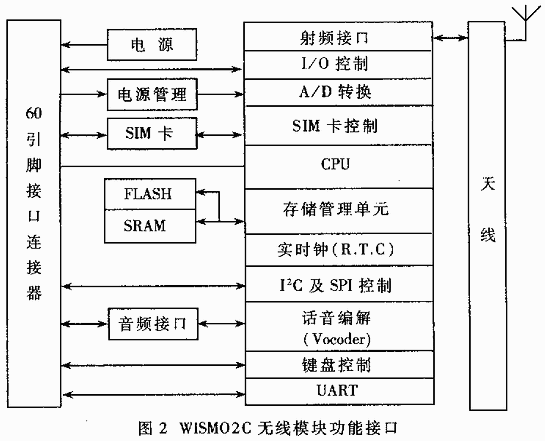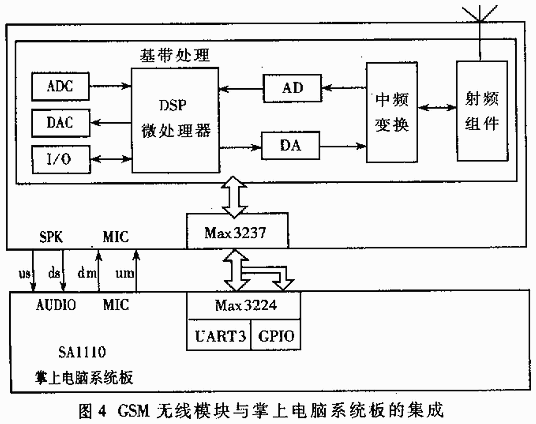Abstract: A handheld computer (HPC) with wireless communication is an important aspect of high-end applications for handheld devices. With reference to the design of GSM mobile phones, the specific functions and interfaces of the WISMO2C GSM wireless dual-frequency module are introduced, and the design scheme and specific implementation of integrating the WISMO2C dual-frequency wireless module in a palmtop computer based on the Intel SA1110 processor are proposed.
At present, most of the wireless Internet access of handheld devices is realized through mobile phones, and the typical representative with more powerful functions is Motorola's A6188. However, the mobile phone's less powerful CPU, smaller memory, smaller display and very limited load capacity restrict its widespread use as an Internet terminal. Compared with mobile phones, handheld computers can highlight their unique advantages in this regard: powerful CPU with high speed, large memory, large-screen color display relative to mobile phones, and easy-to-operate touch screens. In addition, the function of the handheld computer has also been greatly expanded by enhancing the ability to wirelessly access the network. Considering the richness of domestic GSM network resource production and business, the use of existing GSM modules facilitates the rapid and highly reliable integration of wireless communication functions on handheld computers. At present, wireless technology has undergone two generations of development, and it is evolving to the 3G broadband mobile communication system network. The proposed broadband access method provides attractive prospects for handheld computers to wirelessly apply mobile broadband multimedia applications in the near future. At present, GPRS, which is the transition from GSM network to 3G, has been able to provide users with a transmission rate of up to 164kbps. Therefore, it is a general trend to add wireless communication modules to handheld devices, and it is also a sign of the development of handheld devices to a new stage. 
1 Overall design
A palmtop computer with integrated wireless communication function based on Intel SA1110 processing chip, considering the complexity of running network software applications, it is appropriate to use Intel SA110 with a main frequency of 206MHz as the processing chip. In addition to the unlimited module function interface, the handheld computer also implements a USB interface, PCMCIA interface, 320 & TImes; 240 color LCD display and touch screen interface, audio encoding / decoding interface, SIM card, infrared product and shortcut function key interface. 32M bytes of program / data memory is used in the design of the handheld computer, which is convenient for expanding network applications. The operating system used is THOS [1], a Linux-like embedded real-time operating system, which can be used to access the Internet through a wireless module in conjunction with the corresponding underlying driver.
In terms of hardware, handheld computers require miniaturization, power saving, and high reliability. The wireless communication module and other modules are integrated in the handheld computer, and a dedicated integrated circuit is used. In the design process, it is also necessary to consider the suppression of electromagnetic interference and electromagnetic compatibility design.
At present, in addition to the production of ordinary mobile phones, GSM mobile communication manufacturers usually also provide GSM communication modules for use in other products. The selected GSM wireless communication module is the WISMO2C GSM dual-frequency module provided by WAVECOM. In addition to supporting the existing second-generation protocol, this module supports GPRS by upgrading embedded software without changing the hardware structure and external interface.
The overall functional architecture of the palmtop computer system after integrating the wireless communication module is shown in Figure 1.
2 WISMO2C dual frequency wireless module
2.1 Features, functions and interfaces of WISMO2C wireless module [2]
WISMO2C is the second-generation wireless dual-band wireless module that conforms to the E-GSM900 / GSM1800 (or E-GSM900 / GSM1900) standard launched by WAVECOM. Among them, the size is compact (58.3mm & TImes; 32.2mm & TImes; 60mm), using 3.6V standard power supply, with EGSM / 2W, DCS / 1W transmission power, and complete electromagnetic shielding measures are taken for the module itself. The digital baseband processing part adopts 0.35μm mixed VLSI COMS process, and the functional interface description of the module is shown in Figure 2. 
(1) Power supply interface: The input adopts standard 3.6V lithium battery, and other power supplies that meet the ripple coefficient requirements can also be used as input.
(2) SIM card interface; directly provides a 3V SIM card interface that conforms to the GSM11.12 specification. If you want to interface with a 5V SIM card (GSM11.11 standard), you can rely on an external 3V ~ 5V level converter (such as LTC1555) to achieve.
(3) Voice input and output interface: including two microphone input and output interfaces.
(4) RF antenna circuit interface.
(5) I / O interface, including GPIO interface, UART interface, keyboard and SPI interface.
It should be noted that for vertical application development (such as handheld computers), the keyboard and SPI interface may not be used. And because the FLASH and SRAM in the module have a certain remaining space, you can use the programming function to fully utilize the interface function of GPIO through programming when the software development kit is obtained.
The above interfaces provide abundant control interface resources for integrating the GSM module and the handheld computer system. These interfaces are provided by a 60-pin universal connector.
2.2 Realization of circuit function interface
The SIM card directly selects the 3V SIM card that complies with the GSM11.12 specification. The 3V SIM card does not provide C4 and C8 pins. However, because the module provides the SIM card detection input pin SIM_PREP, so choose the SIM Plug in card holder with card detection input. After the card is inserted, a low level signal is given on the SIM_PREP pin, so that the module can enter the working state correctly. Moreover, in GSM11.11, the 6th pin C6 of the 5V SIM card interface is defined as the programming voltage Vpp, while GSM11.12 defines that the 3V SIM card and the 3V-based mobile terminal (ME) do not provide support for this function. It is compatible to connect this pin to the output VCC_MODULE of WISMO2C.
The audio interface uses the SPK2 and MIC2 interfaces with its own bias, and is directly output or connected to the audio part of the handheld computer through a filter network composed of capacitors and inductors. 
The serial port driver is implemented with a MAX3237. Because the output of the WISMO2C wireless module is a standard 3V CMOS level, the 3.6V lithium battery needs to pass the MAX8885EU3.0 (or LP2981) step-down transformer to provide a separate 3V VCC to the MAX3237. In order to protect sensitive parts such as SIM card and serial port output from radio frequency and spike interference, high-speed anti-static tubes ESDA6V1L and DAL6V1L are used to protect them.
The main part of the circuit interface formed by the SISMO2C wireless module is shown in Figure 3.
2.3 AT command set control interface [3]
The software part of the WISMO 2C wireless module provides an external AT command set to control the operation of the system. By receiving the AT command sent from the UART, it interprets and executes the corresponding operation, so as to realize the corresponding function of the wireless modem. This can omit some interfaces such as LCD and keyboard, saving resources. The AT command set used by the handheld computer to communicate with the wireless module through RS-232 includes the following aspects:
(1) General control commands: including SIM card detection and phone status setting.
(2) Call control commands: including dialing, automatic dialing, redialing, hanging up, answering, automatic answering, generating DTMF dial tone, volume control, echo suppression and other commands.
(3) Network service commands: including signal quality, service provider selection, etc.
(4) Complete management commands: including PIN input, phone lock, password modification, etc.
(5) Telephone book management commands.
(6) Short message sending and receiving management commands.
(7) Data and fax control commands, etc.
The handheld computer motherboard provides a 65535 compatible UART driver. Direct programming of 65535 control registers can be used to send AT commands, wireless module response signals, and work status detection, and display the content on the handheld computer LCD screen. .
3 Wireless communication module integrated with PDA
3.1 Integrated solution
The scheme of GSM module and palmtop computer system integration is shown in Figure 4. The communication between the GSM module and the motherboard of the handheld computer is mainly done through the serial port. Since SA1110 I / O port is standard 3.3V CMOS level and WISMO2C is 3V CMOS level, in order to solve the problem of inconsistent level interface and avoid interference between boards, the SA1110 UART3 port is converted by RS-232 level conversion Then connect with RS-232 of GSM module. The serial interface provided by SA1110 can only provide TXD and RXD, while the GSM module also requires the use of RI, CD, RTS, CTS, DSR and DTR signals. For this purpose, use the GPIO pins of SA1110 to connect these signals. SA1110 provides 28 programmable GPOO pins [4] [5], each pin can be configured as an input or output by programming the GPIO pin direction control register (GPDR), and can be set by rising / falling The edge detection enable register (REDER / FEDER) detects the sudden change of the signal of the corresponding pin to realize the monitoring of the output of the wireless module. 
The MIC input signal of the wireless module is directly realized by the built-in MIC input on the motherboard of the handheld computer. SPK is output in parallel to the dedicated voice processing chip UDA1341TS VIN1 port of the handheld computer, making full use of the voice processing function of the chip and the storage capacity of the handheld computer to realize the telephone recording function.
3.2 Electromagnetic compatibility (EMC) design
Electromagnetic interference (EMI) is the difficulty in the integration of handheld computers and wireless modules. In this design, the maximum operating frequency of the CPU chip in HPC reaches 206MHz, while the SDRAM used also works at 100MHz, and the operating frequency of the GSM module is 900 / 1800MHz, which is equivalent to 4 times the former, and the peak transmit power reaches 2W. If not handled properly, they will become each other's major sources of interference. There are many circuits that require pulsed high voltage, such as liquid crystal and backlight, in the system. How to overcome radio frequency interference to ensure the normal operation of the entire system is a primary and most important issue. The necessary measures have been taken mainly from the following aspects.
(1) The choice of devices, try to use SMD packaged devices, avoid the use of DIP type devices, minimize the current emission (induction) loop area, and save the layout area.
(2) Multi-layer PCB board is used, with emphasis on the wiring of key signal lines (SIM clock, data lines, etc.), such as ground wire isolation, shielding and other measures for separate wiring [6].
(3) Reasonably arrange the position of the device, especially the relationship between the position of the SIM card and the position of the RF interface, and avoid parallelism.
(4) Take shielding measures for wireless modules and sensitive devices of the handheld computer.
The integrated wireless communication function of the handheld computer introduced in this article fully takes into account the resource advantages of the existing GSM network wireless access and the availability of the existing modules, and takes full advantage of the processing and display advantages of the handheld computer to quickly and reliably achieve the high-end of handheld computer products. upgrade.
Dc Servomotor,Brushless Dc Servo,Small Brushless Dc Motor,200W-400W Dc Servo Motors
Jinan Keya Electron Science And Technology Co., Ltd. , https://www.keyaservo.com